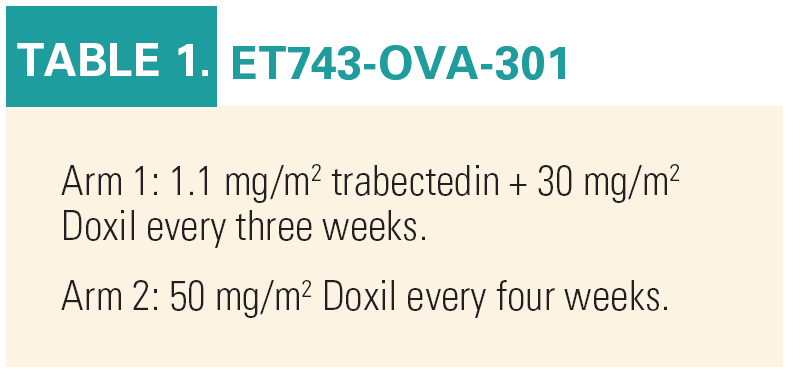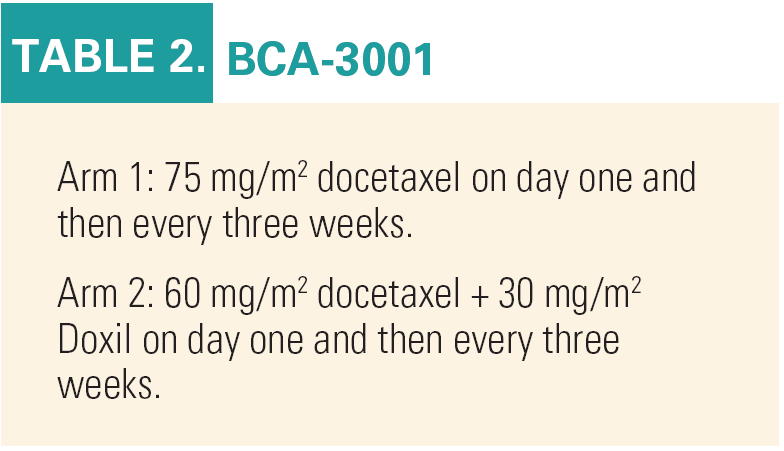New Doxil-based regimens don’t fly with FDA advisors
WASHINGTON, DC-Two separate new drug applications, for the treatment of relapsed ovarian cancer and advanced breast cancer, failed to win the approval of FDA’s Oncologic Drugs Advisory Committee.
WASHINGTON, DC-Two separate new drug applications, for the treatment of relapsed ovarian cancer and advanced breast cancer, failed to win the approval of FDA’s Oncologic Drugs Advisory Committee.
In its NDA for trabectedin (Yondelis), Ortho Biotech described the agent as having a unique mechanism of action when combined with pegylated liposomal doxorubicin (Doxil), giving patients with relapsed ovarian cancer the option of a non-platinum-, non-taxane-containing regimen.
The company also submitted a supplemental NDA for Doxil in combination with docetaxel (Taxotere) for locally advanced or metastatic breast cancer in patients who have received prior anthracycline-based therapy.
Ovarian cancer indication
The international pivotal clinical trial (ET743-OVA-301) was an open-label, phase III study comparing trabectedin/Doxil with Doxil alone. The primary endpoint was progression-free survival (PFS).
Patients (n = 672) who had recurring disease after one platinum-containing regimen were randomized to two arms (see Table 1). Patient status was evaluated independently by radiologists and oncologists, with a third specialist stepping in to adjudicate if there was disagreement.

Median PFS was 7.3 months for the combination regimen and 5.8 months for doxorubicin alone (P = .019). Median overall survival was 20.5 months and 19.4 months, respectively (P = .15).
Grade 3 and 4 toxicity included neutropenia, hand-and-foot syndrome (HFS), stomatitis-mucositis, neuropathy, rhabdomyolysis, transaminase elevations, and congestive heart failure.
Ortho Biotech maintained that these events were mostly transient and consistent with toxicities seen with each individual agent. There were no new toxicities with the combination regimen, the company said.
Ortho Biotech claimed that the study demonstrated an improved overall response rate, as well as an overall survival trend for trabectedin plus Doxil.
The FDA reported several concerns with the study results:
• The sponsor amended the original primary endpoint of overall survival (OS) to PFS after 68% of patients had been randomized.
• Fifteen percent of patients received more than one type of chemotherapy prior to the study, which was not allowed.
• Many imaging studies were not sent to an independent radiologist, as required by the protocol.
• Final analysis of the overall survival data was not available at the time of the ODAC meeting on July 15, 2009.
• Transaminase elevations occurred in 50% of the combination regimen patients, which was higher than reported by the sponsor. FDA representatives said the agency was very concerned about the incidence of liver toxicity.
• Because of adverse events, 77% of patients had dose delays, 44% had dose reductions, and 24% had to stop treatment altogether.
Ultimately, the committee said that the balance of risk/benefit was problematic and that the sponsor’s claims of improved PFS rates were unreliable because progression was measured by imaging studies alone.
Breast cancer indication For the breast cancer indication, Ortho Biotech’s pivotal study (BCA-3001) had a primary endpoint of time-to-progression (TTP) and consisted of 751 patients randomized to two arms (see Table 2). The study met its goal in that median TTP for docetaxel alone was 7.0 months and 9.8 months for the combination, a statistically significant difference.
Once again, toxicity was a problem. There was a marked increase in hand-and-foot syndrome and stomatitis in the combination arm. Thirty-four percent of all patients in the combination arm had to discontinue Doxil permanently because of toxicity.

Ortho Biotech argued that Doxil as a single agent, and in combination with docetaxel, had a favorable safety profile, while also demonstrating significantly improved TTP, PFS, and overall response rates.
The FDA expressed the following reservations about the study results:
• The study accrued poorly in the U.S. (4% of total) and was conducted in Russia and Eastern Europe, where standards of care for treatment of metastatic breast cancer may differ.
• Many study subjects were missing important baseline disease characteristics (ER, PR, and HER2 status) that impact prognosis and dictate treatment for advanced breast cancer in the U.S.
• The Sponsor changed the primary endpoint from OS to TTP well into the conduct of the study.
• There was only a modest improvement in TTP and no difference in OS. The response rate was poor.
• The combination regimen had a higher incidence of overall and grade 3 and 4 toxicity than did docetaxel alone, and 34% of patients discontinued Doxil because of an adverse event, compared with 9% of patients on docetaxel alone.
ODAC voted unanimously that the benefit/risk analysis was not favorable for this indication.
Newsletter
Stay up to date on recent advances in the multidisciplinary approach to cancer.